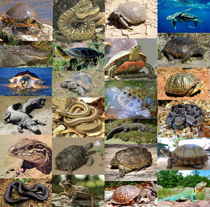
South Carolina Symbols
South Carolina State Reptile
Loggerhead Sea Turtle

(Caretta Caretta)
Adopted on June 1, 1988.
The Loggerhead Sea Turtle, (Caretta Caretta,) was designated as the official reptile of the State by the General Assembly on June 1, 1988, by Act No. 588. Loggerhead Sea Turtles are recognized as a threatened specie and the destruction of their nesting habitat further threatens them with extinction. They perform extended migration between their feeding grounds and rookeries, and South Carolina is considered to have some of the most pristine nesting areas used by Loggerhead Sea Turtles on the eastern coast.
South Carolina State Reptile: Loggerhead Sea Turtle

The only remaining extant member of this genus is the loggerhead sea turtle. It is known for it's relatively large head (thus the name Loggerhead). Loggerheads have a characteristic large head, but it is not because they house a large brain, instead, the space is used for their closing muscles to the jaws. There are two subspecies to Caretta caretta , the other is C. caretta gigas, found in the Pacific and Indian Oceans. C. Caretta caretta differ from gigas by the number of marginal laminae (C. Caretta caretta have 7-8 while gigas have 7-12). Also, the neural bones of the Atlantic species are not interrupted by pleurals, and their front flippers possess two claws. The carapace is reddish-brown with five or more pleural scutes. The broad head varies from reddish-olive brown to yellow.
Characteristics of the Loggerhead Sea Turtle
Food Habits
Atlantic loggerheads are carnivorous and eat sponges, jellyfish, horseshoe crabs, clams, and oysters. They have extra powerful jaws which enable them to easily crush the hard shells of their prey.
Reproduction
Loggerhead Sea Turtle reaches sexual maturity at 12-35 years when their shells are no longer than 50 cm., with Lutz and Musick (1997) reporting 25-35 years. Copulation occurs at sea at no particular time of day or night. Nesting occurs throughout the summer, predominately at night on ocean beaches with well drained sand dunes. The eggs, which are 40-42 mm in diameter, are laid in the flood of spring tides. The eggs are placed in a nest, which is usually chosen in an undisturbed area of well- drained dunes or grassy vegetation. The female comes ashore and climbs up to the high tide line, she then stops and thrusts her snout in the sand to make a shallow hole. Once the hole is dug and the eggs are laid, the nest is then covered by the turtle using her hind flippers. Incubation lasts for a period of 31-65 days. There is usually 120 eggs per clutch, and the female lays two clutches at an interval of thirteen days. The females come ashore to nest only at night in the spring and summer. Eggs require up to 60 days to develop before hatching. Females may nest 2 - 4 times per season, with 4 nests per season reported by Hopkins and Murphy (1984). The eggs in the nest usually hatch around the same time, and the babies quickly move together to the water leaving behind their only terrestrial life stage.
Behavior
Except for western Caribbean populations, all of the nesting areas are located either north of the Tropic of Cancer of south of the Tropic of Capricorn.
For reasons unknown, the Atlantic loggerheads are unable to co-exist with the Olive Ridley Turtle.
The Atlantic loggerheads move long distances only over the coastline region; they come out into the open ocean to sleep.
They migrate to nest by following vegetation laden ocean currents.
Locomotion is by primarily swimming, and walks while nesting on ocean beaches
Habitat
The loggerhead turtle is circumglobal, and inhabits continental shelves, bays, estuaries, and lagoons in temperate, subtropical, and tropical waters
throughout the world. In the Atlantic, the loggerhead turtle's range extends from Newfoundland to as far south as Argentina, with no clear home-ranges
defined to date (Lowe et al. 1990). They spend most of their time in a pelagic environment. They frequent undisturbed beaches for nesting. Sometimes
they are found in freshwater streams and rivers, such as the Mississippi River.
Biomes: temperate coastal, tropical coastal, freshwater rivers
The South Carolina Law
The law designating the loggerhead turtle as the official South Carolina state reptile is found in the South Carolina Code of Laws, Title 1, Chapter 1, Article 9, Section 1-1-625.
Title 1 - Administration of the Government
CHAPTER 1. GENERAL PROVISIONS
ARTICLE 9. STATE EMBLEMS, PLEDGE TO STATE FLAG, OFFICIAL OBSERVANCES
SECTION 1-1-625.
SECTION 1-1-625. Official State reptile.
The loggerhead turtle (Caretta caretta) is the official reptile of the State.
HISTORY: 1988 Act No. 588, Section 1.
Taxonomic Hierarchy: Loggerhead Turtle
Kingdom: Animalia - animals
Phylum: Chordata - chordates
Class: Reptilia
Order: Testudines
Family: Cheloniidae
Genus: Caretta
Species: Caretta caretta







